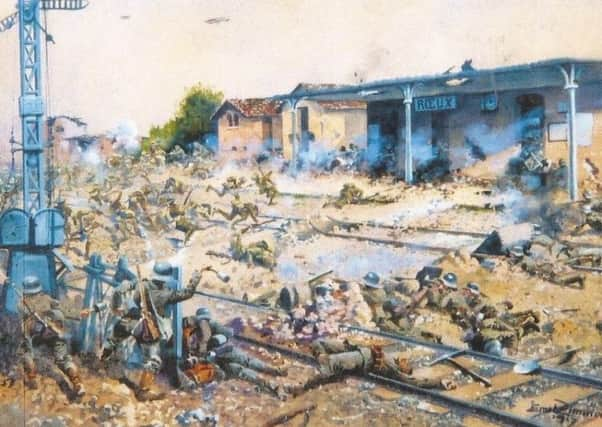Deadly attacks at the Chemical Works


On April 9, 1917, British and Commonwealth troops went on the attack at Arras, advancing several miles on the heels of an exceptionally effective artillery barrage. They reach the 'Green Line' roughly around the small village Fampoux, about one mile away over rolling fields lies the even smaller village of Roeux.
At its heart lies a railway station and a sugar factory, known to the British as the Chemical Works. The troops, with typical black humour though, christen it the ‘Comical Works’.
Advertisement
Hide AdAdvertisement
Hide AdThe weather is most unseasonal, despite being Easter. Gale force winds blow. It’s well below freezing and snow is falling intermittently. General Allenby, commanding Third Army, issues his order of the day on April 10. “The Army Commander wishes all troops to understand that Third Army is now pursuing a defeated enemy and that risks must be freely taken. Isolated enemy detachments in farms and villages must not be allowed to delay the general progress. Such points must be marked and passed. They can be dealt with by troops in the rear.”
In reality the Germans are far from beaten. Taking advantage of inactivity by the British on April 10, they race reserves to the area around the Chemical Works, turning it and Roeux, with its network of tunnels, into a veritable fortress. It is decided that the 2nd Seaforth Highlanders will attack the following morning. What follows can only be described as horrific.
At 1200 precisely the Seaforths and Royal Irish Fusiliers set off. They stuck out like sore thumbs against the blanket of snow which made the going slippery. The artillery barrage was ineffective and no shells fell on the Chemical Works. Ahead lay 1500 yards of open ground over which the Highlanders had to advance without support. Accounts state that there were over 30 MGs trained on the advancing troops.
Despite this some of the Seaforth Highlanders, under young Lt Donald MacKintosh, pushed the Germans back near to the Railway Station. Here they came across trenches that were not marked on their maps and dug in.
Advertisement
Hide AdAdvertisement
Hide AdThey held on desperately under the command of Mackintosh, who was badly wounded having been shot twice. Rallying his men he is wounded a third time, this time fatally, and his men are overrun by a counter attack. None of them returned.
Mackintosh was awarded the Victoria Cross for his heroism. Staggeringly the Highlanders take 93 per cent casualties; every officer amongst them. The Regimental Sgt Major is said to have sat down in the snow and cried for 'his laddies'.
Amongst the dead is Henry Brown from Roslin. In the Brigade War Diary a line is marked on the map, next to it are the words, 'Line of dead Seaforth Highlanders'. The snow continues to fall until little mounds cover their bodies. The following day it is decided another attack will be made by the 9th Scottish Division.
The troops had spent a third night in the open without proper clothing, food or shelter. Many could barely stand and have to be helped to their feet. The snow had stopped leaving nigh on perfect visibility. As soon as the men emerged from the village they are were met by a hurricane of machine gun fire.
Advertisement
Hide AdAdvertisement
Hide AdThey had no chance what so ever. What little barrage they had took off at the twice the agreed speed leaving them behind. They advanced two to three hundred yards before the attack faltered. It was all over bar the dying in about 30 minutes.
The day had been a complete and utter disaster. Casualties are appalling – around 1,400 men are killed, wounded or missing. Amongst the dead are L Cpl David Naysmith from Rosewell, Pte WIlliam Hare from Newtongrange, Pte William Ayton from Bonnyrigg, who are commemorated on the Arras Memorial. It may well be that he is one of the 'unknowns' who lie at rest in the cemetery at Browns Copse, where Henry Brown is buried, as is Pte Thomas Pendrich from Howgate. The fighting at the Chemical Works goes on for several weeks, changing hands a number of times, before it is finally captured by the 51st Highland Division on May 16. They described the fighting there as the worst and bloodiest of the whole war.